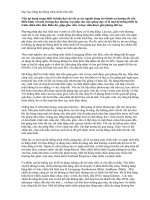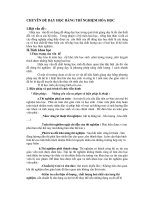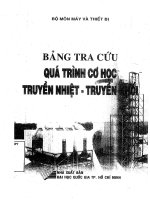- Trang chủ >>
- THPT Quốc Gia >>
- Sinh học
Day hoc bang tra cuu 2
Bạn đang xem bản rút gọn của tài liệu. Xem và tải ngay bản đầy đủ của tài liệu tại đây (134.72 KB, 44 trang )
<span class='text_page_counter'>(1)</span><div class='page_container' data-page=1>
Inquiry-Based Teaching
<b>Dạy học bằng tra cứu</b>
A Workshop for the
Center for Professional Development
School of Education, Can Tho University
<b>Lớp tập huấấn </b>
<b>TRUNG TÂM PHÁT TRIỂỂN NGHIỆP VỤ SƯ PHẠM</b>
<b>Khoa Sư phạm – Đại học Cấần Thơ</b>
<b>John M. Dirkx, Ph.D.</b>
Higher, Adult and Lifelong Education
Michigan State University
</div>
<span class='text_page_counter'>(2)</span><div class='page_container' data-page=2>
Day Two
<b>Ngày thứ hai</b>
How to Implement
Inquiry-based Teaching
</div>
<span class='text_page_counter'>(3)</span><div class='page_container' data-page=3>
Feedback from Day One
</div>
<span class='text_page_counter'>(4)</span><div class='page_container' data-page=4>
Review of Day One
<b>Nội dung ngày thứ nhấấ</b>
<b>t</b>
• What is inquiry-based teaching?
<b>PP dạy học bằng tra cứu là gì?</b>
• Why it is important?
<b>Tại sao PP này quan trọng?</b>
• Theory that supports inquiry-based teaching
<b>Cơ sơỂ lý thuyếất</b>
</div>
<span class='text_page_counter'>(5)</span><div class='page_container' data-page=5>
The Inquiry-based Process
<b>Quá trình tra cứu</b>
Demonstration and discussion
</div>
<span class='text_page_counter'>(6)</span><div class='page_container' data-page=6>
Form Teams
<b>Lập nhóm</b>
• Organize into teams of five to six
members each
<b>Lập thành nhóm 5 hoặc 6 </b>
• Stay with this team for the duration of our
discussion of the inquiry-based process
<b>Giữ nguyên c</b>
<b>ác nhóm trong thời </b>
</div>
<span class='text_page_counter'>(7)</span><div class='page_container' data-page=7>
<b>Basic Stages of Inquiry-based Learning</b>
<b>Các giai đoạn cơ baỂn trong q </b>
<b>trình học bằng tra cứu</b>
• Select a theme
<b>Chọn một đếầ tài</b>
• Identify the question or problem related to theme
<b>Xác định cấu hoỂi hoặc vấấn đếầ liến </b>
<b>quan đếấn đếầ tài</b>
• Identifying what is needed to address the
question or focus
</div>
<span class='text_page_counter'>(8)</span><div class='page_container' data-page=8>
<b>Basic Stages of Inquiry-based Learning</b>
<b>Các giai đoạn cơ baỂn trong quá </b>
<b>trình</b>
<b> học bằng tra cứu</b>
• Using resources to address the question or
problem
<b>SưỂ dụng các nguồần tham khaỂo đếỂ tìm </b>
<b>giaỂi đáp / giaỂi pháp </b>
• Prepare report of what is learned about the
question
</div>
<span class='text_page_counter'>(9)</span><div class='page_container' data-page=9>
Selecting a Theme
<b>Chọn đếầ</b>
<b> tài</b>
Of interest and relevance to the learners
<b> Hấấp dấẫn và thích hợp với ngườI học</b>
Offers a number of possibilities for
questions and paths of inquiry
<b>Đưa đếấn nhiếầu khaỂ nắng tìm hiếỂu, tra </b>
<b>cứu </b>
Will likely generate additional inquiry
</div>
<span class='text_page_counter'>(10)</span><div class='page_container' data-page=10>
Our Theme
<b>Đếầ</b>
<b> tài</b>
Inquiry-based teaching
<b>Dạy học bằng tra cứu</b>
Briefly discuss among your team members your
current understanding of what you know
about this theme
</div>
<span class='text_page_counter'>(11)</span><div class='page_container' data-page=11>
Break
</div>
<span class='text_page_counter'>(12)</span><div class='page_container' data-page=12>
<b>Framing Questions to Guide the Inquiry</b>
<b>Đặt cấu ho</b>
<b>Ểi đếỂ</b>
<b> định hướng </b>
<b>tra cứu</b>
• Students determine what they need to learn
within the theme
<b>SV quyếất định cấần học những gì theo </b>
<b>đếầ tài</b>
• Draft “good questions” on which to base their
inquiry
</div>
<span class='text_page_counter'>(13)</span><div class='page_container' data-page=13>
<b>Qualities of “Good Questions”</b>
<b>Cấu ho</b>
<b>Ểi hiệu qua</b>
<b>Ể</b>
• Something the learner is interested in
<b>Là một điếầu gì đó hấấp dấẫn người học</b>
• Open to research or inquiry
<b>MơỂ hướng nghiến cứu / tra cứu</b>
• Students don’t already know the answer
<b>Người học chưa biếất cấu traỂ lời</b>
</div>
<span class='text_page_counter'>(14)</span><div class='page_container' data-page=14>
<b>Qualities of “Good Questions”</b>
<b>Cấu ho</b>
<b>Ểi hiệu qua</b>
<b>Ể</b>
• Have a clear focus
<b>Có trọng tấm rõ ràng </b>
• Credible information exists that can be
used to research the question
<b>Thồng tin đáng tin cậy có thếỂ sưỂ</b>
</div>
<span class='text_page_counter'>(15)</span><div class='page_container' data-page=15>
Fostering Student Questioning
<b>Phát triếỂ</b>
<b>n kỹ nắng đặt cấu </b>
<b>ho</b>
<b>Ểi</b>
Triggered brainstorming
<b>Động não</b>
“Quescussions”
</div>
<span class='text_page_counter'>(16)</span><div class='page_container' data-page=16>
Identifying Question for Our Inquiry
<b>Xác định cấu ho</b>
<b>Ểi cho hướng </b>
<b>tra cứu</b>
• In your teams: <b>Trong nhóm:</b>
– Brainstorm questions around our theme
<b>Đặt cấu hoỂi vếầ đếầ tài ‘dạy học bằng </b>
<b>tra cứu’</b>
– Review list of questions and refine or revise
<b>Xem lại các cấu hoỂi và chiỂnh sưỂa </b>
– Select one or two questions that will further guide your
</div>
<span class='text_page_counter'>(17)</span><div class='page_container' data-page=17>
Identifying Resources Needed
<b>Xác định nguồầ</b>
<b>n tài liệu cấầ</b>
<b>n </b>
<b>thiếấ</b>
<b>t</b>
• What is needed to address the questions you have
identified? <b>Những gì cấần thiếất đếỂ tìm ra giaỂi </b>
<b>đáp cho các cấu hoỂi đặt ra?</b>
– Primary literature – <b>Tài liệu tham khaỂo gồấc</b>
– Secondary literature - <b>Tài liệu tham khaỂo liến quan tài </b>
<b>liệu gồấc</b>
– Original research – <b>Các nghiến cứu đấầu tiến</b>
• How can the use of these resources best be used to
address your questions?
</div>
<span class='text_page_counter'>(18)</span><div class='page_container' data-page=18>
In Your Teams:
Trong
nhóm:
• Review your questions
<b>Xem lại cấu hoỂi</b>
• Identify what resources are needed to address the
question
<b>Xác định các nguồần tài liệu cấần thiếất</b>
• Briefly discuss how you will go about using these
resources to answer your questions
</div>
<span class='text_page_counter'>(19)</span><div class='page_container' data-page=19>
Drawing Conclusions and Preparing the Report
<b>Kếấ</b>
<b>t luận và chuấỂ</b>
<b>n bị báo </b>
<b>cáo</b>
• Implement the plan developed to study the questions
<b>Tiếấn hành kếấ hoạch nghiến cứu các cấu hoỂi</b>
• Review and critically assess information gathered
<b>Xem xét và đánh giá các thồng tin thu thập </b>
<b>được</b>
• Draw conclusions about what was learned about the
questions
<b>Kếất luận những gì đã tìm hiếỂu được đếỂ traỂ </b>
<b>lời các cấu hoỂi</b>
• Prepare your report
</div>
<span class='text_page_counter'>(20)</span><div class='page_container' data-page=20>
In Your Teams:
Trong nhóm
• Discuss what your findings might look
like
<b>Tha</b>
<b>Ểo luận kếấ</b>
<b>t qua</b>
<b>Ể tìm được sẽ </b>
<b>như thếấ</b>
<b> nào</b>
• Decide on the way in which you would
prepare and present your findings
</div>
<span class='text_page_counter'>(21)</span><div class='page_container' data-page=21>
Assessing the Learning Process
<b>Đánh giá quá trình học</b>
• Students reflect on process and assess what they
learned
<b>SV nhớ lại quá trình học và đánh giá </b>
<b>những gì đã học được</b>
• Students may also assess peers but grading is the
teacher’s job
<b>SV cũng có thếỂ đánh giá bạn học, nhưng </b>
<b>giáo viến là người cho điếỂm</b>
• Students may also identify questions for future
research
</div>
<span class='text_page_counter'>(22)</span><div class='page_container' data-page=22>
<b>Review of the Inquiry-based Process</b>
<b>Q trình tra cứu</b>
• Start with theme
<b>Bắất đấầu bằng một đếầ tài</b>
• Generate questions
<b>Đặt cấu hoỂi </b>
• Design process to address questions
<b>Dự kiếấn q trình tìm tịi giaỂi đáp</b>
• Implement the study
</div>
<span class='text_page_counter'>(23)</span><div class='page_container' data-page=23></div>
<span class='text_page_counter'>(24)</span><div class='page_container' data-page=24>
A Few More Issues
<b>Thếm vài vấấ</b>
<b>n đếầ</b>
• Role of the teacher in the inquiry-based
process
<b>Vai trò cu</b>
<b>Ểa giáo viến trong q </b>
<b>trình dạy học bằng tra cứu</b>
• Role and use of questions in inquiry-based
teaching
</div>
<span class='text_page_counter'>(25)</span><div class='page_container' data-page=25>
Role of the Teacher in
Inquiry-based Learning
<b>Vai trò cu</b>
<b>Ểa giáo viến </b>
</div>
<span class='text_page_counter'>(26)</span><div class='page_container' data-page=26>
<b>Important Teacher Characteristics</b>
<b>Tính cách quan trọng cu</b>
<b>Ểa giáo </b>
<b>viến</b>
• Believe in inquiry-based teaching
<b>Có lịng tin vào phương pháp này</b>
• Higher order thinking skills
<b>Kỹ nắng tư duy mức độ cao</b>
• Knowledge of the subject matter
<b>Có kiếấn thức chuyến mồn</b>
</div>
<span class='text_page_counter'>(27)</span><div class='page_container' data-page=27>
<b>Key Teacher Behaviors</b>
<b>Hành động</b>
• Allow time for transition from traditional ways
of teaching and learning
<b>Cho thời gian đếỂ thay đồỂi từ dạy </b>
<b>và học theo PP truyếần thồấng</b>
• Ask open-ended or divergent questions
<b>Đặt cấu hoỂi mơỂ - khồng giới hạn </b>
<b>cấu traỂ lời </b>
• Wait for students to think and respond
</div>
<span class='text_page_counter'>(28)</span><div class='page_container' data-page=28>
<b>Key Teacher Behaviors</b>
<b>Hành động</b>
• Repeat and paraphrase what students say
<b>Nhắấc lại và diếẫn giaỂi lại phát biếỂu </b>
<b>cuỂa SV</b>
• Avoid telling students what to do, praising,
rejecting, or discouraging
<b>Tránh baỂo SV làm gì, tránh khen </b>
</div>
<span class='text_page_counter'>(29)</span><div class='page_container' data-page=29>
Role and Use of Questions in
Inquiry-based Teaching
<b>Vai trò và việc sưỂ</b>
<b>dụng cấu ho</b>
<b>Ểi trong quá </b>
</div>
<span class='text_page_counter'>(30)</span><div class='page_container' data-page=30>
<b>Important Things to Know about Good </b>
<b>Inquiry Questions</b>
<b>Những điếầu quan trọng cấần biếất vếầ</b>
<b>cấu hoỂi</b>
<b> tra cứu hiệu quaỂ</b>
• Something student is interested in
<b>Là một điếầu gì đó hấấp dấẫn người học</b>
• Open to research
<b>MơỂ hướng nghiến cứu</b>
• Don’t already know the answer
<b>Người học chưa biếất cấu traỂ lời</b>
</div>
<span class='text_page_counter'>(31)</span><div class='page_container' data-page=31>
<b>Important Things to Know about Good Inquiry </b>
<b>Questions</b>
<b>Những điếầu quan trọng cấần biếất vếầ</b>
<b>cấu hoỂi</b>
<b> tra cứu hiệu quaỂ</b>
• Have a clear focus
<b>Có trọng tấm rõ ràng</b>
• Should be reasonable
<b>Hợp lý </b>
• Doesn’t reflect a premise
<b>Khồng dựa vào một giaỂ thuyếất nào đó </b>
• Define terms within the question
</div>
<span class='text_page_counter'>(32)</span><div class='page_container' data-page=32>
<b>Important Things to Know about Good Inquiry </b>
<b>Questions</b>
<b>Những điếầu quan trọng cấần biếất vếầ</b>
<b>cấu hoỂi</b>
<b> tra cứu hiệu quaỂ</b>
• Leads to a new question when answered
<b>Cấu traỂ lời đưa đếấn một cấu hoỂi </b>
<b>mới</b>
• The answer matters
</div>
<span class='text_page_counter'>(33)</span><div class='page_container' data-page=33>
The Tension
<b>Sự cắng thắỂ</b>
<b>ng</b>
Too easy
Quá dễễ
Too hard
Quá khó
Cognitively
challenging but
still doable
</div>
<span class='text_page_counter'>(34)</span><div class='page_container' data-page=34>
Break
</div>
<span class='text_page_counter'>(35)</span><div class='page_container' data-page=35>
Developing Lesson Plans for
Inquiry-based Learning
</div>
<span class='text_page_counter'>(36)</span><div class='page_container' data-page=36>
The Lesson Plan
Giáo án
• More specific than the syllabus
• <b>Cụ thếỂ hơn so với đếầ cương mồn học</b>
• A roadmap or guide for teachers to organize and
plan individual teaching sessions
</div>
<span class='text_page_counter'>(37)</span><div class='page_container' data-page=37>
Example of a Lesson Plan
<b>Ví dụ: g</b>
<b>iáo án</b>
Workshop Lesson Plan
</div>
<span class='text_page_counter'>(38)</span><div class='page_container' data-page=38>
Components of a Lesson Plan
<b>Các yếấ</b>
<b>u tồấ</b>
<b> cu</b>
<b>Ểa một giáo </b>
<b>án</b>
• Objectives for the lesson
<b>Mục tiếu bài học</b>
– Knowledge, skills, and attitudes you want students
to acquire
– <b>Kiếấn thức, kỹ nắng và thái độ mà bạn </b>
<b>muồấn SV đạt được</b>
</div>
<span class='text_page_counter'>(39)</span><div class='page_container' data-page=39>
Components of a Lesson Plan
<b>Các thành tồấ</b>
<b> cu</b>
<b>Ểa một giáo </b>
<b>án</b>
• Materials and resources needed for the
lesson
• <b>Tài liệu và nguồần tham khaỂo cấần thiếất </b>
<b>cho bài học</b>
• Approximate breakdown of topics and activities by
time
• <b>Chia các chuỂ đếầ và hoạt động phù hợp </b>
<b>với thời gian</b>
• Students’ prior knowledge, if possible
• <b>Liến hệ với kiếấn thức đã có cuỂa HS </b>
<b>(nếấu có thếỂ)</b>
</div>
<span class='text_page_counter'>(40)</span><div class='page_container' data-page=40>
<b>Các yếu tố của một giáo án</b>
• Space, room arrangements and equipment
requirement
• <b>Khồng gian lớp học, sắấp xếấp bàn </b>
<b>ghếấ, dụng cụ cấần thiếất</b>
• Instructional strategies to be used in the
lesson
• <b><sub>Các chiếấ</sub><sub>n lược gia</sub><sub>Ểng dạy sẽ dùng </sub></b>
</div>
<span class='text_page_counter'>(41)</span><div class='page_container' data-page=41>
Content of a Lesson Plan
<b>Nội dung cu</b>
<b>Ểa giáo án</b>
• Introduction
<b>Giới thiệu</b>
• Body
<b>Nội dung</b>
</div>
<span class='text_page_counter'>(42)</span><div class='page_container' data-page=42>
Review of Day Two
Ơn tập ngày thứ hai
• Basic stages of inquiry-based process
• <b>Các giai đoạn cuỂa q trình tra cứu</b>
• Implementing the inquiry-based process
• <b>Tiếấn hành q trình tra cứu</b>
• Additional considerations for effectively using the inquiry-based
process
</div>
<span class='text_page_counter'>(43)</span><div class='page_container' data-page=43>
For Day Three
<b>Nội dung ngày thứ ba</b>
• How inquiry-based lessons plans differ from traditional format
• <b>Giáo án theo hướng tra cứu khác biệt như </b>
<b>thếấ nào với giáo án truyếần thồấng?</b>
• Developing an inquiry-based lesson plan
• <b>Soạn giáo án theo hướng tra cứu</b>
• Sharing your plans
• <b>Chia seỂ các kếấ hoạch cuỂa bạn</b>
• Workshop conclusion
</div>
<span class='text_page_counter'>(44)</span><div class='page_container' data-page=44>
Classroom Assessment
<b>Đánh giá lớp học</b>
• What are the one or two most important things
you have learned so far?
• <b>Một hoặc hai điếầu quan trọng nhấất </b>
<b>bạn đã học được qua đợt tập huấấn là </b>
<b>gì? </b>
</div>
<!--links-->









